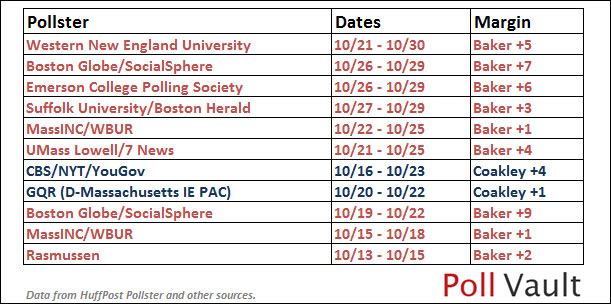Advertisement
Final Polls Show A Clearer Edge For Baker
The polling is almost all in, with just one to go later Friday (UMass Amherst/WBZ-TV) and one Saturday (Public Policy Polling). Nine of the last 10 public, nonpartisan polls have now shown an edge for Republican Charlie Baker. The four new polls from the last day showing between a 3- and 7-point lead provide enough evidence to tilt away from Thursday’s uncertainty to more confidence that Baker’s lead is real. The HuffPollster odds of a Baker win are now at 65 percent, up from 54 percent just a few days ago. It’s still too close to say for sure that he will win, but we can be more sure he is leading in the polls.

The exception to the polls showing Baker leading is the CBS/New York Times/YouGov poll showing Democrat Martha Coakley with a 4-point edge. It’s not clear what would cause YouGov results to differ from the rest of the polls published. They have a good track record, so dismissing them out of hand is certainly not a wise choice. The other poll showing Coakley with a nominal edge (1 point) was a Democratic poll sponsored by the Massachusetts IE PAC.
The lead shown in nearly all of the polls have been within the individual poll’s margin of error. But in such cases, if most or all of the polls show one candidate ahead, each increases the odds that the candidate is actually leading. The reason is basically this (with some simplification): Suffolk University showed a 46-43 lead for Baker. Taking into account statistical variation, there is about a one in four chance that Coakley is actually ahead. Looking at the UMass-Lowell poll’s 45-41 lead for Baker, the chances are a bit smaller. But the chances that both leads are artifacts of statistical noise are much smaller. So, with nearly all of the polls showing Baker ahead, the odds that the polls have all missed due to the margin of error are vanishingly small.
This is different than saying he will win. Polls can also systematically miss, as they did in this year's state primaries. This can happen for a variety of reasons, from big changes in turnout, last minute shifts in voter preference, negative headlines for one candidate, under-sampling particular groups of voters, or undecided voters breaking heavily in one direction. In this particular election, the less likely voters lean heavily toward Coakley. So the more unlikely voters the Democratic get-out-the-vote machine can turn out, the more the final margin will move in Coakley's direction.
[asset]2014/0929_baker-coakley/[/asset]
Also, the size of Baker’s lead is near (though just outside) the range of previous polling misses in Massachusetts. In four of the last five Massachusetts elections, polls have underestimated Democratic performance by 1.8 and 3.5 points. As of this writing, the HuffPollster model places Baker’s estimated lead at 4.4 points. If the same underestimate is present in this year’s polls, the race could be closer. And more to the point, the one in three chance the model gives of a Coakley win should be taken as just that. When a model says Baker has a 65 percent chance of winning, the model should be wrong about the winner 35 percent of the time.
On the flip side, with these polls representing the first moment of a clear Baker lead, it is also possible the race is still moving in Baker’s direction with a few days to go. The swing from early, pro-Coakley polls to today is clear, and we can’t say for sure whether it is over or not. And accounts of the Coakley field organization on Primary Day were far less than stellar, meaning her operation may not be able to turn out her voters in the numbers needed to keep the race tight.
So I will revise Thursday’s statement, and say there is now reason for more confidence that Baker is leading, given the reasonably consistent set of final polls. But with just a few days to go, no one should think this is a foregone conclusion.